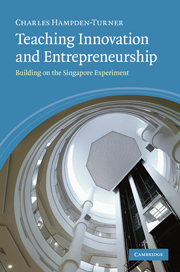Book contents
- Frontmatter
- Contents
- List of grids
- List of dilemmas
- Acknowledgements
- Introduction
- 1 Singapore’s challenge
- 2 The entrepreneurial ecosystem
- 3 How can innovative pedagogies be measured?
- 4 Co-defining innovative education
- 5 The Singapore results
- 6 Results of the Mandarin-speaking programme
- 7 Reconciling values
- 8 ‘It is only the Hawthorne Effect’
- 9 The programme that cannot stand still
- 10 Innovation and the future of the university
- 11 What are the implications of being able to teach innovation?
- 12 Is a new creative class arising?
- Notes
- Bibliography
- Appendices
- General index
- Index of dilemmas and reconciliations
12 - Is a new creative class arising?
Published online by Cambridge University Press: 05 July 2014
- Frontmatter
- Contents
- List of grids
- List of dilemmas
- Acknowledgements
- Introduction
- 1 Singapore’s challenge
- 2 The entrepreneurial ecosystem
- 3 How can innovative pedagogies be measured?
- 4 Co-defining innovative education
- 5 The Singapore results
- 6 Results of the Mandarin-speaking programme
- 7 Reconciling values
- 8 ‘It is only the Hawthorne Effect’
- 9 The programme that cannot stand still
- 10 Innovation and the future of the university
- 11 What are the implications of being able to teach innovation?
- 12 Is a new creative class arising?
- Notes
- Bibliography
- Appendices
- General index
- Index of dilemmas and reconciliations
Summary
The evidence suggests that the Singapore Experiment is not an isolated example. Richard Florida, a geographer, and several other writers have suggested that what might be happening is nothing less than a worldwide phenomenon he calls The Rise of the Creative Class. If such a class is arising not just in America, but in Europe and East Asia, then what is set out in this book may be an effective way of teaching a new class of innovators and creative employees. This research might be even more widely relevant.
Florida began by imagining a time traveller who had switched from 1900 to 1950 and again from 1950 to 2000 and beyond. At first blush the half-century to 1950 contained most of the world-changing surprises, the automobile, the Federal Highway System, the aeroplane and jet engine, the airline industry, radio and television, the telephone and even the first computer. The world of 1900 would be barely recognizable from the heights of Manhattan skyscrapers.
Yet the time traveller from 1950 to 2000 would recognize most, if not all, of our technologies. Admittedly, computers have become personal and telephones mobile and we are now connected to the Internet, but the general principles were not so far apart. Our traveller to 2000 would not be whisked out of his horse and buggy and brownstone into a totally transformed world. He would surely be less bewildered. Perhaps this is so, but our traveller could be bewildered for different reasons. What changed in the first part of the century was the physical infrastructure.
- Type
- Chapter
- Information
- Teaching Innovation and EntrepreneurshipBuilding on the Singapore Experiment, pp. 179 - 196Publisher: Cambridge University PressPrint publication year: 2009



